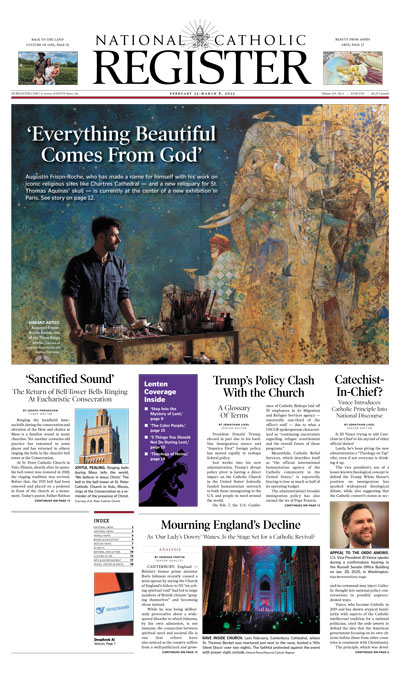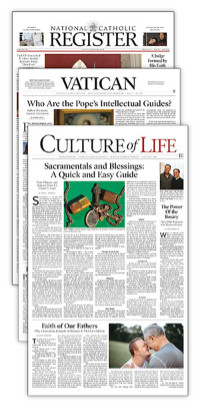Notre Dame’s Reopening Highlights the Historic Church-State Tensions Between Paris and Rome
COMMENTARY: The celebration of the restoration of France’s famed cathedral is happening on the same weekend as a consistory of new cardinals at the Vatican, providing an intriguing juxtaposition rich with symbolism.

In Catholic news, a consistory to create new cardinals in Rome is always the dominant story of the day. But not this Saturday, as all Catholic eyes and the attention of much of the world will be fixed on Paris for the reopening of Notre Dame Cathedral.
The new (2022) archbishop of Paris, Laurent Ulrich, will not be required in Rome as he will not be created a cardinal. As with many other traditional cardinalatial sees, Pope Francis has not granted the red hat to Paris, neither to Archbishop Ulrich nor his predecessor. Nevertheless, scheduling a consistory for the same date as the previously planned reopening of Notre Dame does mean a division of attention.
The two ceremonies highlight the long and tangled history of church and state.
The consistory in Rome is undeniably an ecclesial affair, presided over by the universal pastor of the Church, but held upon the territory of the sovereign Vatican City State, in which the Holy Father holds supreme executive, legislative and judicial power — something the kings of France at the zenith of their power aspired to wield.
Meanwhile, in Paris, Notre Dame — as with many churches in France — is owned by the French state. In 1790, just after the French Revolution, the new government expropriated all of the Church’s property. That massive theft was moderated in 1801 with a concordat between Napoleon and the Holy See. Some properties were returned and a measure of religious freedom was restored.
A century later, another bout of church-state conflict ensued, with bitter battles between France and the Holy See. That was resolved in the compromise that prevails today. The French state owns all churches built before 1905, and is obligated to pay for their upkeep and allow the Church the free use of the buildings.
Thus French President Emmanuel Macron was ultimately responsible for the physical restoration of Notre Dame after the 2019 fire. He had ultimate authority, though in practice the Archdiocese of Paris was extensively consulted. The French state does not regulate the worship and Catholic practice inside Notre Dame.
That outside/inside dynamic will be dramatically manifest on Saturday. Macron, as impresario of the restoration, initially planned that he would address the reopening ceremony from inside the cathedral. That archdiocese objected to what would appear to be the French head of state presiding over the rededication of a cathedral.
In the grand French style, a compromise was worked out. Macron will address the opening ceremony, but while in the plaza outside the cathedral. The ceremony will then proceed with Archbishop Ulrich knocking on the doors of Notre Dame, then entering to lead the worship and rituals of dedication.
The vast assembly of heads of government — including U.S. President-elect Donald Trump — will attend, but it will not be a Mass. The first Mass will be Sunday morning, and will include many bishops and priests from Paris and across France.
Pilgrims in Rome will also notice that inside/outside dynamic if they are attentive upon entering St. Peter’s Basilica. The massive portico of the basilica is flanked on either side by two monumental equestrian statues, one of Constantine and the other of Charlemagne. The former is considered one of Bernini’s masterpieces.
The two statues honor significant civil patrons of the Church; it can be argued that Emperor Constantine is more important in Church history than most of the popes and saints commemorated inside.
Yet Constantine and Charlemagne remain outside the basilica proper. They are close to the Church, supportive of her, but not — in their civil office — part of her from the inside. That is much contested in historical practice, to be sure, but the principle is maintained — both at St. Peter’s and at Notre Dame.
Charlemagne was the first Holy Roman Emperor crowned in St. Peter’s, in A.D. 800. After the French Revolution and Napoleon’s concordat with the Holy See in 1801, Napoleon himself wanted a coronation as emperor of France, but in Notre Dame — not in Reims Cathedral, where previous French kings had been crowned. He prevailed upon Pope Pius VII to come from Rome for the coronation. The ceremony was a mix of both church and state; the Holy Father retired to the sacristy for the civil oath-taking — a kind of inside/further inside dynamic!
Napoleon’s decision to be crowned at Notre Dame established anew the cathedral at the center of French life. The rest of the 19th century marked a new period in Notre Dame’s life, with Victor Hugo’s novel and an extensive renovation project.
Pope Pius VII’s overtures to Napoleon — the concordat of 1801 and the coronation of 1804 — did not work out entirely smoothly. Pius VII had come to the papacy in difficult circumstances. In 1798, post-revolutionary French troops invaded Rome, kidnapped Pope Pius VI and took him prisoner in France. He died there in 1799. Pius VII was elected in 1800 and initially sought some kind of arrangement with Napoleon. But by 1809, the French troops were back in Rome and took Pius VII to France as a prisoner. He was held there for five years, until Napoleon’s first exile in 1814.
The restored Notre Dame soars upward to the heavens. But it reaches far back into the tangled roots of church-state conflicts in France.
A coda to the twin ceremonies in Paris and Rome will come next week when Pope Francis visits the French Mediterranean island of Corsica — a visit to France for a conference, but not to Paris for Notre Dame. While flying into Corsica, the birthplace of Napoleon, the Holy Father will be able to see the nearby island of Elba, where the French emperor spent his first exile, during which Pius VII was able to return to Rome.
















